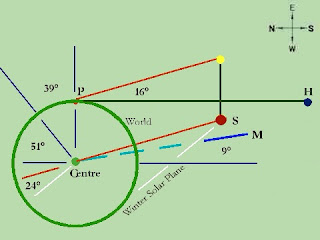A 'Geocentric' worldview is the idea that our World is fixed: The heavens revolve about us.
‘There lies in the Ocean an island no smaller than Sicily. This island, the account continues, is situated in the north and is inhabited by the Hyperboreans, who are called by that name because their home is beyond the point whence the north wind (Boreas) blows … And there is also on the island both a magnificent sacred precinct of Apollo and a notable temple which is adorned with many votive offerings and is spherical in shape … The account is also given that the god visits the island every nineteen years, the period in which the return of the stars to the same place in the heavens is accomplished.’ Diodorus Siculus, Library of History 2.47.
It will help to read this post first (Of Hyperion we are told....)
Imagine standing on a fixed geocentric world at a latitude of 51 degrees (Salisbury, England): This worldview can be represented by the solar planes (now 23.5 degrees either side of the Equatorial line, though 24 degrees in 2400BC), together with the blackness of the sphere which appears to revolves around the polar axis:
Take this vision of this World and look at the Winter Solstice; a solar position that happens to coincide with the raised mound around Station Stone 92 at Stonehenge - for detailed explanation see blog post Of Hyperion we are told:
From the centre of the World (Point C), the Sun (S) is located along the solstice solar plane (dashed line). In the UK at winter solstice, it rises from the horizon by an angle of about 16 degrees:
By standing on our world (at P) and drawing a horizon line to a south point H, we can show how high up the sun travels at the Winter Solstice:
We can also define the moon at it's furthest lunar standstill. Every nineteen years, the Moon reaches it's major standstill in the Southern Hemisphere (at about 30 degrees from the equatorial plane in 2400BC). However, both the Moon and the Sun appear to eclipse; so those who believe themselves on a geocentric world, because they do not know if the Moon is in front or behind, might only define the Moon's line and not its exact position:
To represent the solar circle, we can draw a circle around the Sun showing its peak above the horizon:
Now we'll draw this with dots:
The Avebury Circle (near Stonehenge, England):
A circle with a centre representing the World and its hinge drawn in stone: Avebury North Inner Circle
The Earth's centre: Avebury's 'Cove'
The Earth's centre: Avebury's 'Cove'
The sun's Winter Solstice point (from the Earth's Centre): Avebury's Obelisk
The Sun's winter solstice movement line placed @ 16 degrees: South Inner Circle
The moon's variable location placed @ 9 degrees: Avebury's Stone Row
The stars beyond of the firmament: Avebury's outer circle
The outer blackness: Avebury's ditch & bank
The outer blackness: Avebury's ditch & bank
Diodorus Siculus tells us that a Geocentric model (world fixed with heavens revolving above) was discovered long before Roman records began. Avebury and Stonehenge fit Diodorus's description.
We also know that Northern Europeans often travelled to Britain in Neolithic Times.
Is it possible that the North of Europe knew the nature of the heavens thousands of years before Aristotle and Ptolemy?
Is it possible that the North of Europe knew the nature of the heavens thousands of years before Aristotle and Ptolemy?








Debate has raged since the time Diodorus Siculus wrote that (c.50 BC) over whether he was talking about Britain or Ireland. "Hyperborea" was a name tossed blithely around for places to the North 'where dwell dragons'. Beyond the margin of most maps.
ReplyDeleteI always wanted to believe he was talking about Stonehenge, but not due to the reference of A Spherical Temple so much as the 'Every 19 Years' remark. The most northerly Lunar Standstill at 18.6 years is most definitely indicated by the North Barrow Stone at the Henge as viewed from Stone 91.
(Also, in Latin, Spherical can also mean Circular.)
Anyway, there's my two-cents.
Best wishes Jon!
Neil
Thanks Neil. It may be very signficant that Avebury's stone line points to exactly the same line as the 18.6 year lunar return. I remember thinking it was a degree or so out until George pointed out that the apparent Southern Hemisphere orbital path was 30.1 degrees in 2400BC;
ReplyDeletehttp://www.megalithic.co.uk/modules.php?op=modload&name=Forum&file=viewtopic&topic=4660&forum=4&start=263
The alignment of the moon (above) becomes precisely as measured with this angle: And every other angle is also precisely correct.
Tell me more about the alignment of 91?
Hi Jon,
ReplyDeleteThe 18.6 year Lunar high standstill alignment is viewed from Stone 91 across to Stone 94. If I recall, (and don't hold me to this!) the last one occurred in 1998 or something.
This represents the Moon's most northerly setting. Just another of the many peculiarities associated with being ~51 degrees North Latitude.
I hope your Holiday is a pleasant one!
Neil
Thanks Neil,
ReplyDeleteSo many different effects seem to be achieveable at 51 degrees; perhaps that's the reason it was chosen?
Jon
There seems to be, in addition to the rather alarming preponderance of growing evidence on the Pro side, that the Neolithic Peoples' were also well-aware of where the Earth's Cool Spots were located.
ReplyDeleteCircumstances arrived at by calculated fore-knowledge as well as sheer coincidence (e.g. the Periglacial Ice Striations)allowed them to determine where precisely these Citadel's should be located.
+/- 51 degrees N is the ONLY place the various remarkable alignments seem to work..
Very weird stuff contrived by a very bright folk.
Neil
Hi Neil
ReplyDeleteAny news on the latest developments? I have so much work on at the moment that I haven't been able to attend to Stonehenge as much as I would like.
Do you have a link for the other alignment correlations?
All the best
Jon